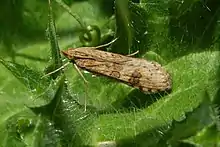Nomophila nearctica
Nomophila nearctica, the lucerne moth, clover nomophila, false webworm, celery stalkworm or American celery webworm, is a moth of the family Crambidae. It is known from southern Canada and all of the United States, south to Mexico and the Neotropics.
| Nomophila nearctica | |
|---|---|
 | |
.jpg.webp) | |
| Scientific classification | |
| Domain: | Eukaryota |
| Kingdom: | Animalia |
| Phylum: | Arthropoda |
| Class: | Insecta |
| Order: | Lepidoptera |
| Family: | Crambidae |
| Genus: | Nomophila |
| Species: | N. nearctica |
| Binomial name | |
| Nomophila nearctica | |
The wingspan is 24–35 mm. When at rest, adults keep their wings overlapped and hugged against the abdomen, giving a long and narrow profile. The forewing is elongate, grayish-brown with two side-by-side dark oval spots near the middle of the wing, and another dark bilobed spot a little farther out. The hindwings are much broader. They are pale brownish-gray with a whitish fringe.[2]
Adults are on wing from April to November in North America.
The larvae feed on celery, grasses, lucerne, Medicago sativa, Polygonum, Melilotus and various other low-growing herbaceous plants. They have a black head. The abdomen is variably light brown to dark gray with a bumpy surface and sparse long hairs and a thin dark dorsal line bordered by narrow pale strip.
References
- "mothphotographersgroup". Mothphotographersgroup.msstate.edu. Retrieved 2011-10-18.
- "Bug Guide". Bug Guide. Retrieved 2011-10-18.